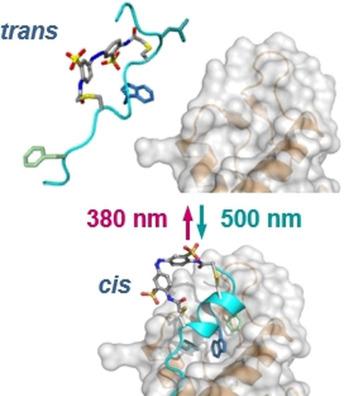当前位置:
X-MOL 学术
›
ChemMedChem
›
论文详情
Our official English website, www.x-mol.net, welcomes your feedback! (Note: you will need to create a separate account there.)
Targeted Nanoswitchable Inhibitors of Protein–Protein Interactions Involved in Apoptosis
ChemMedChem ( IF 3.4 ) Pub Date : 2018-12-10 , DOI: 10.1002/cmdc.201800647 Laura Nevola 1 , Monica Varese 1 , Andrés Martín‐Quirós 2 , Giacomo Mari 1, 3 , Kay Eckelt 2, 4 , Pau Gorostiza 1, 2, 4, 5 , Ernest Giralt 1, 6
ChemMedChem ( IF 3.4 ) Pub Date : 2018-12-10 , DOI: 10.1002/cmdc.201800647 Laura Nevola 1 , Monica Varese 1 , Andrés Martín‐Quirós 2 , Giacomo Mari 1, 3 , Kay Eckelt 2, 4 , Pau Gorostiza 1, 2, 4, 5 , Ernest Giralt 1, 6
Affiliation

|
Progress in drug delivery is hampered by a lack of efficient strategies to target drugs with high specificity and precise spatiotemporal regulation. The remote control of nanoparticles and drugs with light allows regulation of their action site and dosage. Peptide‐based drugs are highly specific, non‐immunogenic, and can be designed to cross the plasma membrane. In order to combine target specificity and remote control of drug action, here we describe a versatile strategy based on a generalized template to design nanoswitchable peptides that modulate protein–protein interactions upon light activation. This approach is demonstrated to promote photomodulation of two important targets involved in apoptosis (the interactions Bcl‐xL–Bak and MDM2–p53), but can be also applied to a large pool of therapeutically relevant protein–protein interactions mediated by α‐helical motifs. The template can be adjusted using readily available information about hot spots (residues contributing most to the binding energy) at the protein–protein interface of interest.
中文翻译:

有针对性的涉及蛋白质与蛋白质相互作用的纳米开关抑制剂,参与细胞凋亡。
缺乏有效的策略来靶向具有高特异性和精确的时空调节的药物,阻碍了药物输送的进展。用光遥控纳米颗粒和药物可以调节其作用部位和剂量。基于肽的药物是高度特异性的,非免疫原性的,可以设计为穿过质膜。为了结合靶点特异性和药物作用的远程控制,在此我们描述一种基于通用模板的通用策略,以设计可在光激活时调节蛋白质间相互作用的纳米可转换肽。事实证明,这种方法可促进涉及凋亡的两个重要靶标的光调节(Bcl-xL-Bak和MDM2-p53的相互作用),但也可以应用于由α-螺旋基序介导的大量与治疗相关的蛋白质间相互作用。可以使用感兴趣的蛋白质-蛋白质界面上有关热点(对结合能贡献最大的残基)的现成信息来调整模板。
更新日期:2018-12-10
中文翻译:

有针对性的涉及蛋白质与蛋白质相互作用的纳米开关抑制剂,参与细胞凋亡。
缺乏有效的策略来靶向具有高特异性和精确的时空调节的药物,阻碍了药物输送的进展。用光遥控纳米颗粒和药物可以调节其作用部位和剂量。基于肽的药物是高度特异性的,非免疫原性的,可以设计为穿过质膜。为了结合靶点特异性和药物作用的远程控制,在此我们描述一种基于通用模板的通用策略,以设计可在光激活时调节蛋白质间相互作用的纳米可转换肽。事实证明,这种方法可促进涉及凋亡的两个重要靶标的光调节(Bcl-xL-Bak和MDM2-p53的相互作用),但也可以应用于由α-螺旋基序介导的大量与治疗相关的蛋白质间相互作用。可以使用感兴趣的蛋白质-蛋白质界面上有关热点(对结合能贡献最大的残基)的现成信息来调整模板。


























 京公网安备 11010802027423号
京公网安备 11010802027423号